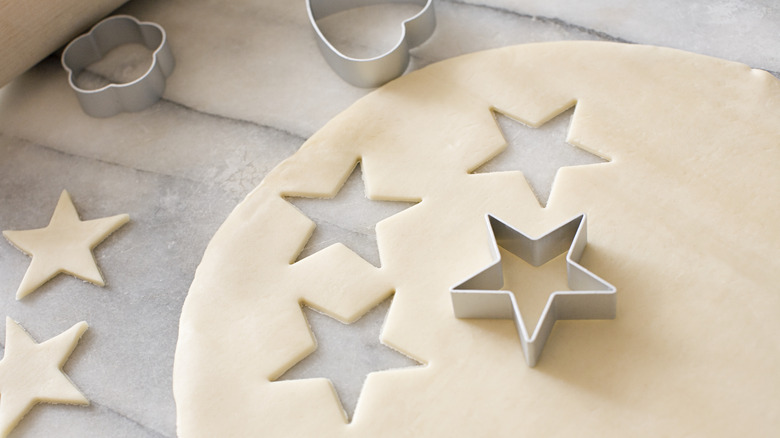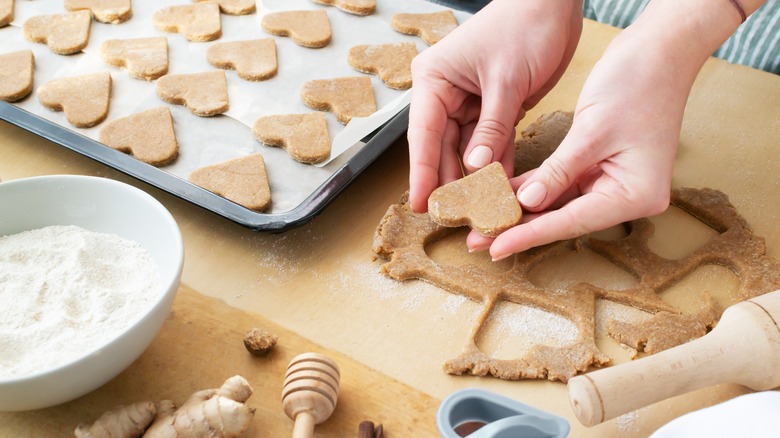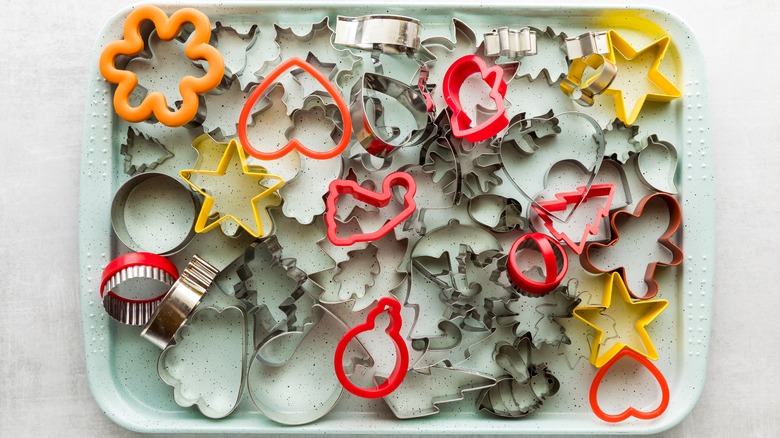How To Prevent Cookie Cutters From Sticking To The Dough
Baking should be an enjoyable process, but few recipes cause more sweating in the kitchen than preparing rolled and cut cookies. Unlike other varieties, such as drop cookies or cookie bars, the rolled and cut kind can be more time-consuming and come with additional challenges, first and foremost the dough sticking to the cookie cutter.
Luckily, there are several solutions to this problem (and once they're decorated with royal icing and sprinkled with sanding sugar, you'll know this labor of love is worth the effort). Before you begin, place roughly ½ cup of flour in a small bowl next to you. Dip the cookie cutter into the flour, ensuring the inside is lightly coated, before stamping out your design. Inspect small corners and little details that are more prone to sticking and flour those as well. If the dough begins to adhere, remove the remnants with a paper towel before using the cutter again, to prevent buildup. Avoid getting the gadgets wet while using them since moisture will only soften the dough and worsen the situation.
If you're wondering whether sprinkling flour on top of the cookie dough would be faster, it's not recommended. Adding too much flour to the recipe will create tough cookies. Confectioners' sugar is another option, or you could lightly coat the inside of the cutters with cooking spray to make them nonstick. When working with chocolate cookie dough, it's best to use sifted cocoa powder, which won't leave white marks on the dark surface.
Tips for making non-sticking cookie dough
While flour is a great solution for sticky dough, it's even better to prevent it from happening in the first place. There are a few reasons why your dough may be sticking to surfaces, and it all starts with temperature. It's essential that rolled and cut cookie dough is adequately chilled. If the butter gets too warm, the dough will stick to everything, including the rolling pin and countertop. Even if you manage to get it onto a cookie sheet, the cookie won't hold its shape when baked.
To prevent this from happening, divide the dough into several flat disks and place them, wrapped, in the refrigerator for a minimum of 30 minutes to several days. Work with one disk at a time, keeping the rest in the fridge, to prevent unused dough from getting soft. Roll the dough on a cool surface like a marble, and avoid placing it near the oven.
If the dough has been refrigerated for days and is still soft, it could have too many wet (and not enough dry) ingredients. Baking is a science; even using the wrong size egg can throw off the recipe. This would be a situation when dusting the surface with flour or cornstarch would help. In the future, ensure you measure correctly using the proper cups for dry and liquid ingredients, or better yet, use a scale for more precision.
Different kinds of cookie cutters matter
Cookie cutters are available in plastic and metal — and at different price points. Metal cookie cutters can be made of tin, stainless steel, aluminum, or copper. Some have a nonstick coating, are dishwasher-safe, or have a grip or handle to hold them easily. Hand-washing is recommended to keep them in the best shape. However, stainless steel won't rust, unlike tin, aluminum, and copper, making them a more durable material (although some are flimsier than others). Ensure these types of cookie cutters are dry before storing to prevent corrosion. Regardless, fine-grit sandpaper or steel wool will remove the rust if, for example, you pick up cookie cutters from a vintage sale or inherit them from your family.
Plastic cookie cutters are the safest option if you do a lot of baking with children. The sides aren't as sharp and they are durable when accidentally dropped on the floor. Plastic cutters also tend to be inexpensive, so you can splurge even if you only plan on using that shape once.
While each material has benefits, metal cutters tend to have thin, sharp edges that create clean lines and make cutting easier, preventing your bumblebee cookie from looking like a moose. Whichever cutter you use, remember to always flour it and then press straight down on the rolled dough to lessen the chance for sticking. And, avoid wiggling it back and forth, which can distort its shape.



